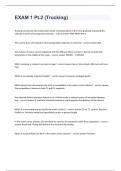Samenvatting
Summary Articles of English Linguistics 2 English and Englishes
- Instelling
- Universiteit Van Amsterdam (UvA)
This summary contains all the articles assigned for the course English Linguistics 2 English and Englishes. These were used for the weekly essay assignments. The summary also contains visuals from the articles in order to create a comprehensive overview.
[Meer zien]













